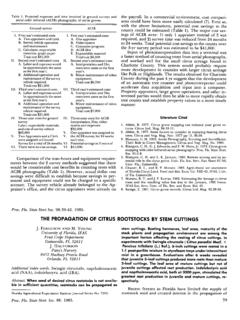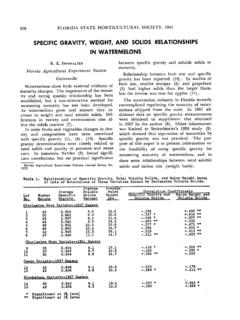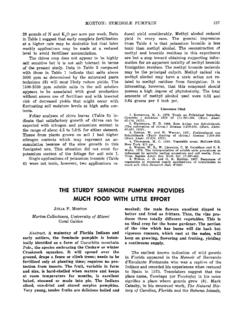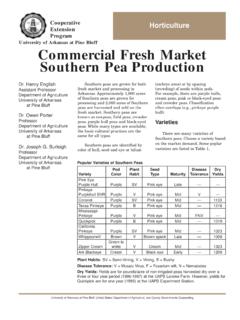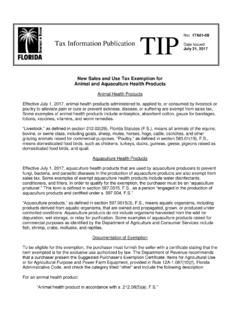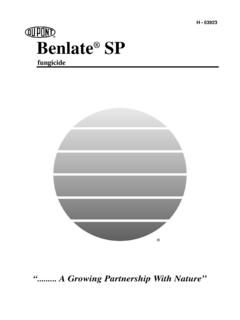Transcription of COMPATIBILITY OF INSECTICIDES, FUNGICIDES, AND
1 SCHENCK AND ADLERZ: WATERMELON fertilizers 209 COMPATIBILITY OF INSECTICIDES, fungicides , AND FOLIAR fertilizers ON WATERMELON N. C. SCHENCK AND W. C. ADLERZ1 Florida Agricultural Experiment Station Leesburg Insecticides, fungicides , and foliar fertilizers are all used in the production of watermelon (Citrullus vulgaris L.) in Florida. In certain areas of the state, particularly in south Florida, pesticides are commonly applied at 5-7 day in tervals to maintain disease and insect control. Growers with large acreages combine insecticides and fungicides so that both can be applied at the required short interval. In addition, materials are combined simply to save the time and labor required to make separate applications. Several pesticide-nutritional spray mixtures have been suspected of causing physical damage to watermelon plants, but no recommendations have been made regarding the phytotoxicity of these spray mixtures because of the lack of ex perimental evidence.
2 In addition, little was known about the pesticidal effectiveness of these mix tures. In 1952, Kelsheimer et al. (3) compared 20 different pesticide-nutrient mixtures for their COMPATIBILITY on several vegetable crops. Al though many of the materials tested in that study are still in use, several new pesticides and nu trients have since become available. Several references report fungicide- insecticide compatibilities on crops other than vegetables (4) (5) (6), but no nutrients were included in these tests, and results are not entirely applicable to vegetable crops. In addition, pesticide mixtures have been compared for COMPATIBILITY in seed treatment of cucurbits (7), peas (8), and corn (1), but these results have little application to the COMPATIBILITY of pesticide mixtures as foliar sprays. The purpose of this paper is to preliminarily report the progress of an evaluation of several pesticide-nutrient combinations for their effect on watermelons.
3 Perhaps this report will stimu late the interest of other researchers to perform similar experiments on other crops and also act as a deterrent to indiscriminate mixing of ma terials in the spray tank. lAssistant Plant Pathologist and Assistant Entomologist, respectively, Watermelon and Grape Investigations Labora tory, Leesburg, Florida. T Florida Agricultural Experiment Stations Journal Series, No. 1579. Materials and Methods Pesticide and pesticide-nutrient mixtures were evaluated in the field on variety Charleston Gray watermelon arranged in plots of 10 hills in 2 paired rows. The experimental design was a ran domized block of 3 replicates, and the entire ex periment was bordered with a row of Fairfax watermelons. In addition, in 1962, separator rows of variety Summit were planted between plots. In 1961 there were 24 treatments consisting of all possible combinations using 1 each of 4 insecticides, 3 fungicides , and 2 foliar fertilizers .
4 Materials and rates (for 100 gallons of water) were as follows: fungicides Dithane Z-78 (75% zineb , Rohm and Haas Co.) at 1 lb. plus Manzate (80% maneb , E. I. duPont de Ne-mours and Co.) at lb.; Captan 50 (50% captan , California Chemical Co.) at 2 lb.; Tribasic Copper Sulfate (53% metallic copper as basic copper sulfate) at 3 lb.; insecticides Dibrom 8E (100% naled emulsifiable liquid, Cali fornia Chemical Co.) at 1 lb.; Diazinon 25W (25% diazinon , Geigy Chemical Co.) at 2 lb.; Phosdrin 25W (25% phosdrin , Shell Chemical Co.) at 1 lb.; Thiodan 50W (50% en-dosulfan , Niagara Chemical Division) at 1 lb.; fertilizers Nugreen (45% urea jntrogen, E. I. duPont de Nemours and Co.) at 4 lb.; ni trate of soda-potash (15-0-14, Chilean Nitrate Sales) at 5 lb. In 1962 there were 48 treatments consisting of all possible combinations using 1 each of 4 insecticides, 4 fungicides , and 3 foliar fertilizer treatments.
5 Materials and rates were as follows: fungicides Dithane Z-78 at 2 lb.; Manzate at lb.; Phaltan (50% folpet , California Chemical Co.) at 2 lb.; Dithane M-45 (16% manganese, 2% zinc, 62% ethylenebisdithiocar-bamate, Rohm and Haas Co.) at 2 lb.; insecti cides Dibrom 8E at 1 lb.; Diazinon 25W, at 2 lb.; Thiodan 50W at 1 lb.; Guthion 25W (25% guthion , Chemagro Corp.) at 2 lb.; ferti lizers Nugreen at 4 lb.; nitrate of soda-potash at 5 lb.; none. Treatments were applied at approximately 125 psi from a Meyers 25-gallon Research Sprayer with a 12-foot boom bearing 11 nozzles. Treat ments were applied at 10-14 day intervals 4 times in 1961 and 6 times in 1962. In both years disease ratings were made at weekly intervals, using a 210 FLORIDA STATE HORTICULTURAL SOCIETY, 1962 Table 1. Effectiveness of various fungicides in the control of watermelon diseases^ 1961 and 1962, Mean disease ratings^ 190I 19o2 Zineb-maneb Copper Captan a< b c Maneb M-45 Folpet Zineb a2 b c c 1 Rating system scale ; = trace of disease, = 100$ infection.
6 2 Values followed by the same letter nonsignificantly different according to analysis of variance. Table 2. Effect of insecticides on the fungicidal control of watermelon diseases, 1961. insecticide Mean Phosdrin Dibrom Diazinon Thiodan disease rating a a a b Table 3. Effect of fertilizers on disease and insect control. 1961 Disease rating 15-0-14 a Nugreen b None 1962 Percent rindworm damaged melons a a b Table 4. Control of rindworm of watermelon by insecticides, 1962 insecticide Guthion Thiodan Diazinon Dibrom Mean percent damaged melons a b" b b modification of HorsfalFs method (2). Melon numbers and weights were recorded twice in 1961 and 3 times in 1962. Melons damaged by rindworm were counted at the time of picking in 1962. Other insect infestations did not develop during either test. Results and Discussion Differences in disease control in 1961 resulted principally from the major effects of fungicides , insecticides, and foliar fertilizers rather than from their interactions.
7 In 1961 zineb-maneb was significantly better than copper, which was significantly better than captan. In 1962 maneb and Dithane M-45 were significantly better than folpet and zineb; maneb was also significantly better than M-45 (Table 1). Disease control with mixtures containing thiodan was significantly less than control with those containing other insecticides (Table 2). Combinations with Nu green were significantly poorer in disease control than those with 15-0-14 (Table 3). A rindworm infestation in 1962 was the only insect problem encountered during these tests. Rindworm damage was significantly less in plots sprayed with guthion than in those sprayed with other insecticides (Table 4). Rindworm damage also was significantly less in plots sprayed with mixtures containing fertilizers than in those sprayed with mixtures not containing fertilizers (Table 3). Rindworm control was re duced when insecticides were combined with di-thiocarbamate fungicides in the absence of fer tilizers (Fig.)
8 1). However, control was not re-SCHENCK AND ADLERZ: WATERMELON fertilizers 211 5 o i o | 66 r 62 56 54 o: 50 46 FOLPET ZINEB MANEB FERTILIZER FOLPET ZINEB MANEB NO FERTIUZER Figure 1. Effect of fungicides and fertilizer combinations on insecticide control of rindworm of watermelons, 1962. duced in similar combinations with folpet. There were no significant differences in yield due to the major effects of fungicides , insecti cides, or foliar fertilizers . Certain combinations were involved in sig nificant interactions indicating apparent incom patibility (Table 5). These interactions were not supported statistically by significant major effects or lower order interactions or both, which con siderably lessens their importance. However, these combinations are worthy of note and fur ther evaluation. Summary In a 2-year study (1961-1962) 72 combina tions of insecticides, fungicides , and foliar fer tilizers were compared for their COMPATIBILITY on watermelon.
9 In these tests disease control was best with zineb-maneb and maneb alone. Disease control with mixtures containing Thiodan or Nugreen was significantly less than with mix tures not containing them. Rindworm control was best with guthion and mixtures containing foliar fertilizers . Insecticidal control was re duced by mixtures containing dithiocarbamate fungicides without fertilizers . Other combina tions showing apparent incompatibility will be tested further. LITERATURE CITED 1. Arnold, E. W. and J. W. Apple. 1957. COMPATIBILITY of insecticides and fungicides used for the treatment of corn seed. J. Econ. Entomol. 50:43-45. 2. Horsfall, James G. 1945. fungicides and their action. Chronica Botanica Co. Waltham, Mass. p. 38-41. 3. Kelsheimer, E. G., James M. Walter, J. R. Becken-bach. 1952. COMPATIBILITY of insecticides, fungicides and nutrients for vegetable crops. Florida Agr.
10 Expt. Sta. Circ. S-47. 6p. 4. Kelsheimer, E. G. 1958. COMPATIBILITY of insecticides Table 5. Pesticide-fertilizer combinations involved in interactions indicating apparent incompatibility in 196l or 1962, Combinations Disease Percent rindworm Yield ratings damaged melons (pounds per acre) Thiodan/zineb-maneb/Nugreen Thiodan/15-0-14 Diazinon/zineb-maneb/Nugreen Phosdrin/captan/Nugreen Dibrom/zineb-maneb/Nugreen Diazinon/M-45/15-0-l4 Diazinon/zineb Experiment mean ----83^7 17,932 9,655 15,100 15,560 -0 20,839 .2 .8 .8 .6 .2 212 FLORIDA STATE HORTICULTURAL SOCIETY, 1962 and fungicides for chrysanthemums. Proc. Florida State Hort. Soc. 71:392-394. 5. Madsen, H. F. and Stanley C. Hoyt. 1962. Compati bility chart of spray chemicals. Western Fruit Grower 16(2):26-29. 6. McBride, J. J., Jr. 1958. Reaction of zineb with copper compounds, oil deposits when applied with zineb and deposits of zineb when applied with a variety of ma terials.


